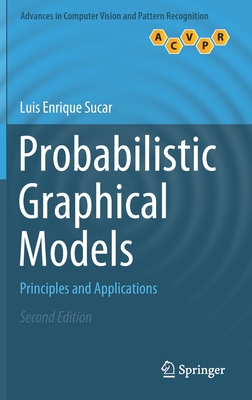Introduction to Statistical Relational Learning (Hardcover)
暫譯: 統計關聯學習導論 (精裝版)
Lise Getoor, Ben Taskar
- 出版商: MIT
- 出版日期: 2007-11-01
- 售價: $2,640
- 貴賓價: 9.5 折 $2,508
- 語言: 英文
- 頁數: 608
- 裝訂: Hardcover
- ISBN: 0262072882
- ISBN-13: 9780262072885
-
相關分類:
Machine Learning
海外代購書籍(需單獨結帳)
買這商品的人也買了...
-
 Windows 驅動程式設計指南 (Programming the Microsoft Windows Driver Model, 2/e)
Windows 驅動程式設計指南 (Programming the Microsoft Windows Driver Model, 2/e)$890$703 -
 Data Mining: Next Generation Challenges and Future Directions (Paperback)
Data Mining: Next Generation Challenges and Future Directions (Paperback)$1,320$1,254 -
 深入淺出設計模式 (Head First Design Patterns)
深入淺出設計模式 (Head First Design Patterns)$880$695 -
 ARM9 S3C2410 嵌入式系統實作
ARM9 S3C2410 嵌入式系統實作$520$468 -
 SQL Server 2005 SSIS 整合服務
SQL Server 2005 SSIS 整合服務$850$672 -
 SQL 語法範例辭典
SQL 語法範例辭典$550$435 -
 柏青哥的 SUSE Linux 10
柏青哥的 SUSE Linux 10$620$527 -
 Linux 驅動程式, 3/e (Linux Device Drivers, 3/e)
Linux 驅動程式, 3/e (Linux Device Drivers, 3/e)$980$774 -
 聖殿祭司的 ASP.NET 2.0 專家技術手冊─使用 C#, 2/e
聖殿祭司的 ASP.NET 2.0 專家技術手冊─使用 C#, 2/e$720$569 -
 Moodle 數位學習課程管理平台
Moodle 數位學習課程管理平台$550$435 -
 Official (ISC)2 Guide to the SSCP CBK
Official (ISC)2 Guide to the SSCP CBK$2,630$2,499 -
 Embedded Linux 開發實務徹底研究 (Embedded Linux Primer: A Practical Real-World Approach)
Embedded Linux 開發實務徹底研究 (Embedded Linux Primer: A Practical Real-World Approach)$720$569 -
 C# 3.0 in a Nutshell: A Desktop Quick Reference, 3/e
C# 3.0 in a Nutshell: A Desktop Quick Reference, 3/e$1,800$1,710 -
 駭客攻防實戰詳解
駭客攻防實戰詳解$580$458 -
 軟體建構之道 (Code Complete, 2/e)
軟體建構之道 (Code Complete, 2/e)$1,200$1,020 -
 Introduction to Machine Learning, 2/e (Hardcover)
Introduction to Machine Learning, 2/e (Hardcover)$1,350$1,323 -
 Google Android SDK 開發範例大全
Google Android SDK 開發範例大全$750$593 -
 $990The CSSLP Prep Guide: Mastering the Certified Secure Software Lifecycle Professional (Paperback)
$990The CSSLP Prep Guide: Mastering the Certified Secure Software Lifecycle Professional (Paperback) -
 Probabilistic Graphical Models: Principles and Techniques (Hardcover)
Probabilistic Graphical Models: Principles and Techniques (Hardcover)$5,260$4,997 -
 深入淺出 PMP (Head First PMP, 2/e)
深入淺出 PMP (Head First PMP, 2/e)$980$774 -
 約耳趣談軟體-來自專案管理的現場實錄 (Joel on Software: And on Diverse and Occasionally Related Matters That Will Prove of Interest to Software Developers)
約耳趣談軟體-來自專案管理的現場實錄 (Joel on Software: And on Diverse and Occasionally Related Matters That Will Prove of Interest to Software Developers)$490$387 -
 無瑕的程式碼 - 敏捷軟體開發技巧守則 (Clean Code: A Handbook of Agile Software Craftsmanship)
無瑕的程式碼 - 敏捷軟體開發技巧守則 (Clean Code: A Handbook of Agile Software Craftsmanship)$580$452 -
 超圖解 Arduino 互動設計入門 (附 Arduino UNO R3 開發板)
超圖解 Arduino 互動設計入門 (附 Arduino UNO R3 開發板)$1,130$893 -
 Arduino UNO R3 開發板(副廠相容版)附傳輸線
Arduino UNO R3 開發板(副廠相容版)附傳輸線$400$380 -
 Android 應用程式開發與設計實務
Android 應用程式開發與設計實務$590$460
商品描述
Description
Handling inherent uncertainty and exploiting compositional structure are fundamental to understanding and designing large-scale systems. Statistical relational learning builds on ideas from probability theory and statistics to address uncertainty while incorporating tools from logic, databases, and programming languages to represent structure. In Introduction to Statistical Relational Learning, leading researchers in this emerging area of machine learning describe current formalisms, models, and algorithms that enable effective and robust reasoning about richly structured systems and data.
The early chapters provide tutorials for material used in later chapters, offering introductions to representation, inference and learning in graphical models, and logic. The book then describes object-oriented approaches, including probabilistic relational models, relational Markov networks, and probabilistic entity-relationship models as well as logic-based formalisms including Bayesian logic programs, Markov logic, and stochastic logic programs. Later chapters discuss such topics as probabilistic models with unknown objects, relational dependency networks, reinforcement learning in relational domains, and information extraction.
By presenting a variety of approaches, the book highlights commonalities and clarifies important differences among proposed approaches and, along the way, identifies important representational and algorithmic issues. Numerous applications are provided throughout.
商品描述(中文翻譯)
**描述**
處理固有的不確定性並利用組合結構是理解和設計大型系統的基本要素。統計關係學習基於概率論和統計學的概念,以解決不確定性,同時結合邏輯、數據庫和程式語言的工具來表示結構。在《統計關係學習導論》中,這一新興機器學習領域的領先研究者描述了當前的形式主義、模型和算法,這些都能有效且穩健地推理豐富結構的系統和數據。
前幾章提供了後續章節所用材料的教程,介紹了圖形模型中的表示、推理和學習。接著,書中描述了面向對象的方法,包括概率關係模型、關係馬可夫網絡和概率實體-關係模型,以及基於邏輯的形式主義,包括貝葉斯邏輯程序、馬可夫邏輯和隨機邏輯程序。後面的章節討論了如未知物體的概率模型、關係依賴網絡、關係領域中的強化學習和信息提取等主題。
通過呈現多種方法,這本書突顯了共同點並澄清了所提方法之間的重要差異,並在此過程中識別了重要的表示和算法問題。全書提供了眾多應用實例。










